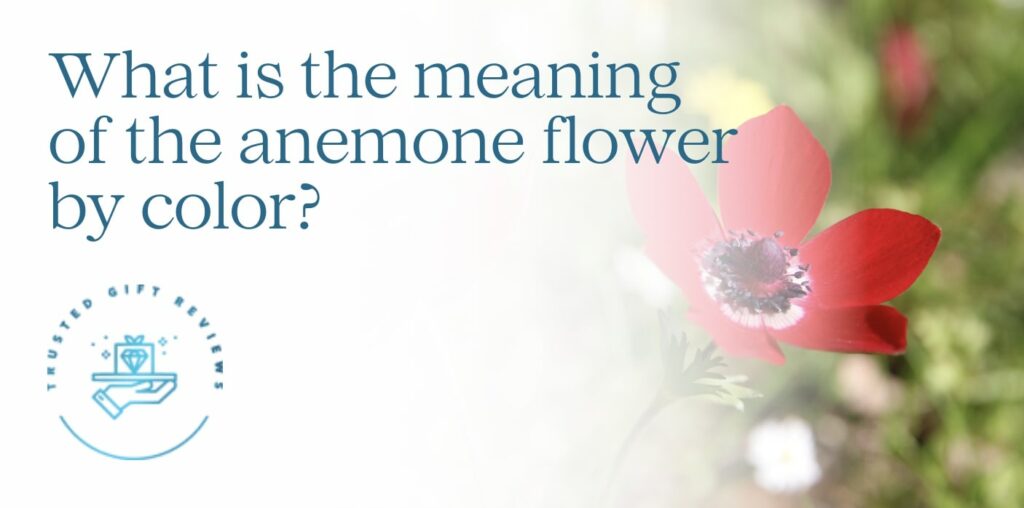Red anemones signify romance and charm; pink means delicateness and fun; blue means trust, honor, and peace. Yellow is bliss and cheerfulness, and last but not least, white stands for faith, purity, and innocence.
To know more about the meaning and symbolism of the lovely anemone flower, keep reading this guide. Later, we’ll also delve into their cultural significance and on what occasion they’re suited for gifting!
Basic Information about Anemones


Genus: Anemone
Family: Ranunculaceae
Native Habitat: Temperate and subtropical regions
Anemone is a sizable genus of flowering herbs belonging to the buttercup (Ranunculaceae) family.
But note that they’re altogether different from the sea anemones, which aren’t really plants but marine animals.
They’re found all over the world in temperate and subtropical climates. This can be anywhere from Mediterranean countries like Greece and Spain to Asian countries such as Japan and China.
Most people cultivate this type of plant in their gardens as ornamentals because of their huge, showy blossoms. They also make for nice bouquets for casual events, weddings, or other special occasions.
Anemone Botanical Description


Flower Width: 8 centimeters
Flower Height: 4 to 8 inches
Blooming Season: Early spring to fall
An attractive but unusual flower, the anemone doesn’t have petals, though they look like them. Instead, the divided or lobed foliage are sepals that surround the plant’s center.
Its center is an elaborate structure, consisting of 10 to 200 stamens and ordinary pistils, which are the reproductive parts of the plant.
Furthermore, they stand on green and healthy stems with branchy clusters of leaves.
Each flower measures 8 centimeters across and the leaf-like sepals grow from 4 to 27 inches thick. They’re low-growing flowers that can reach only a mature height of 4 to 8 inches.
Aside from that, their blooming season is from early spring to fall. The anemone flowers can be seen and enjoyed for about 8 to 10 weeks.
Anemone Word Origin


The name Anemone can be traced back to the Latin word anemōnē of the mid-16th century.
Anemōnē means “windflower” or “daughter of the wind,” alluding to how the flowers open when the wind blows.
Digging deeper, anemōnē was derived from the Ancient Greek word anemṓnē and further back to its Greek mother word ánemos or “wind” in English.
Anemone General Meaning


There are heaps of meanings attached to the anemone plant. Having said that, the most generally regarded meaning is protection from bad intentions and harm.
Also, red and pink anemones, which are the flower’s most common colors, represent forsaken love or death more than its other meanings—even the positive ones.
Since they signify death, red or pink anemones have been used to comfort a loved one who has experienced a loss or to honor the life of a departed person.
Some also say that the opening of the flower’s sepals signals that the spring breeze has arrived, and in contrast, their closing indicates that a rainstorm will soon arrive.
Anemone Meaning by Color


Anemones differ in meaning according to their flower color. Find out what each color symbolizes below.
Red Anemones
Red anemones with their fascinating black-blue center and white rim rival the beauty of flowers like roses, poppies, and daisies.
The color red for anemones has both positive and negative connotations. As we said, it means romance and love, so it’s excellent to give red anemones to your lover or spouse.
However, red also represents arguments and the ego.
In addition, red anemones have been a symbol of forsaken or lost love. Lost love can be due to death or a sudden, unfavorable change of circumstances.
Blue Anemones
Blue is an extraordinary shade for anemones. It suggests coolness, calmness, and serenity in addition to trust, commitment, and peace.
Besides that, it can be regarded as a symbol of excitement and anticipation to meet someone, such as a soulmate or a close family member.
And so, blue anemones are perfect to be given to someone you love and care about or badly miss. Or it can be grown in your garden to add an energetic and magical pop of color.
White Anemones
A popular and traditional choice for wedding bouquets, white anemones are classic, elegant, and sublime.
Similar to other beautiful white blooms, they represent peace, purity, chastity, and spirituality.
Also, because of their demure and majestic appearance, they’re taken to mean sincerity to a person, especially someone you look up to or love.
Whether you are saying “I love you” or “I’m sorry” or are showing sympathy to a grieving person, these flowers could be the right gift to give!
Pink Anemones
Like red anemones, pink anemones are commonly attached to forgotten or failed love.
However, if regarded positively, pink anemones are also symbolic of a lighter, more playful form of romance as well as gentleness and fondness.
You can get pink anemones for someone important to you—for example, your mother, aunt, grandmother, or foster parent—during special occasions like Mother’s Day, birthdays, or Thanksgiving.
Yellow Anemones
Yellow anemones are like a ray of sunshine. Seeing them can lift your heavy mood and, possibly, even make you reminisce about your favorite moments with friends and family.
They particularly mean joy, cheerfulness, and optimism. There’s often no romance involved with giving yellow anemones to someone as a gift.
And they’re wonderful to have on your porch, garden, or entrance where guests and passersby can see them. This may make them feel welcome and put them in a positive mood.
Purple Anemones
Purple anemones are some of the most beautiful blooms out there. They perfectly display dignity, nobility, grace, pride, and luxury.
More importantly, purple means respect, peace, and harmony, which are vital qualities of a relationship.
Having red, blue, and violet in it, purple is sometimes also associated with magic and mystery as well.
If you have a secret crush or someone you admire who has made a big, positive impact in your life, you can give them purple anemones.
Plus, if you’re celebrating important life events, like a 1st or 20th wedding anniversary or 30 years in business, purple anemones can be an excellent choice!
Anemone across Cultures


Let’s now see how the anemone flower is regarded in several countries:
In Greece
- The Tale of Aphrodite and Adonis
In Greek Mythology, the anemone flower is a relevant symbol in the sad tale of Adonis and Aphrodite.
The goddess of love and beauty, Aphrodite, grew quite fond of a mortal boy, Adonis.
They were very much together almost all of the time, that the gods were angered and decided to kill Adonis.
The two lovers went on a hunting trip that was intended to be thrilling. But suddenly, a wild boar gored and mortally wounded Adonis.
Aphrodite held him in her arms while crying tears of sadness and sorrow as she walked back from the woodlands. And where her tears fell, there grew in their places beautiful anemone flowers.
- Anemos, the God of the Wind
Anemos is the Greek god of the wind. Legend says that he scatters anemone flowers across the land to let people know of his arrival in spring.
These two Greek myths are how people have come to associate the anemone flower with death and forsaken love and the arrival of spring winds.
In England
During the Victorian times, roughly spanning the period between 1820 and 1914, the anemone took on the meanings of failed or hopeless love and death.
In Egypt and China
Both these countries regarded anemones as a symbol of bad luck and sickness owing to their unusual colors.
Medicinal Benefits of Anemones
The anemone flower also has amazing health benefits.
Perhaps the most remarkable of which is its anti-cancer property. This is because of the presence of the compound triterpenoid saponins.
Plus, research concluded that the anemone is anti-inflammatory, antibacterial, and can help support the immune system.
What does an anemone flower tattoo mean?


Not many people decide to get a tattoo of an anemone flower due to its dark meanings of death, deserted or ended love, bad luck, and evil intentions.
Despite that, you can still get an anemone tattoo if you want a symbol of protection from spite or disease, love and romance (for red and pink anemones), or elegance and purity (for white anemones).
Captivating Facts about the Anemone Flower


Anemone flowers are as interesting as they look. So, here are some captivating facts about them!
- They’re also called windflowers, poppy anemones, or the lilies of the field.
- Most anemone flowers are scentless.
- Some anemone varieties are considered invasive weeds.
- They’re rarely touched or eaten by deers.




